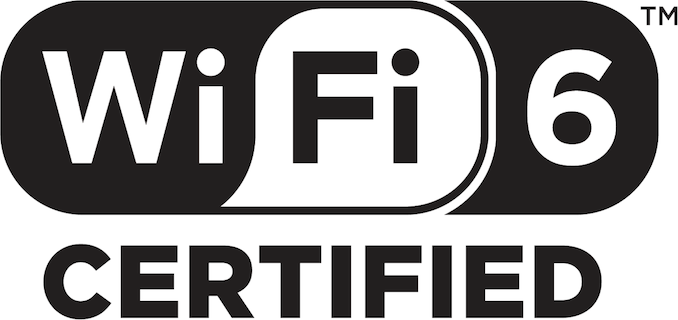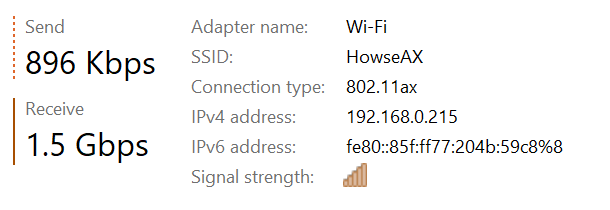AT 101: Wi-Fi 6 And Why You Want It
by Brett Howse on February 12, 2020 8:00 AM ESTTo The Future
If the question is do you need Wi-Fi 6, the answer is most assuredly “maybe”. The performance improvements are substantial, but really rely on a very strong signal to get the most data throughput. Most of the new features of Wi-Fi 6 focus on the influx of devices to the standard, and dealing with many devices connected to the same access point, or devices trying to share spectrum when connected to different access points.
The addition of Orthogonal Frequency Division Multiple Access to the Wi-Fi 6 standard will likely be the most impactful change to this revision. It will allow access points to carve up their channels into smaller slices, allowing more devices to communicate at the same time with less overhead. Each device will lose out on peak throughput, but the reduced latency should help a lot, especially in very dense environments. It should help with excessive overhead on the network layer when multiple devices are sending many small packets at once, which is a very common scenario, especially in an office or stadium situation.
Multi-User MIMO was in the Wi-Fi 5 specification as an optional implementation, and as such it did not really take off. Wi-Fi 6 should make this more prevalent, and also adds support to the MU-MIMO on the uplink, not just the downlink side. This will increase the capacity of access points for higher-speed use cases, but MU-MIMO did not get a lot of traction in Wi-Fi 5 so we will have to see how much adoption it gets in Wi-Fi 6.
The wider 160 MHz channels will offer significantly more throughput in the home environment, as we saw in our performance tests. As with the 1024-level QAM though, to see the biggest benefit you will need a strong signal. The vast majority of home networking is still limited to 1 Gigabit Ethernet, which puts Wi-Fi 6 into somewhat of an awkward spot, since it can transfer faster than most wired home networks, but even so, that is still a significant improvement over Wi-Fi 5 which would cap out around 600 Mbps on the best Wi-Fi adapters. If you work with a lot of large files, and you prefer to use Wi-Fi instead of the more consistent, yet cumbersome Ethernet, there’s still a nice boost to be had.
The future looks strong for Wi-Fi, and the Wi-Fi Alliance has made some excellent revisions to their standard to help improve Wi-Fi for the next generation of devices. As with any standards change, the impacts will not be seen right away. Both the access point, and the client need to be leveraging the new standard for the improvements to be noticeable. We’ve already seen the latest generation of smartphones start to offer Wi-Fi 6, and there’s been some movement in the PC space as well with Intel’s Project Athena. Anyone looking at a new router today should certainly opt for a Wi-Fi 6 model, but there’s likely not a major need for most people to move from Wi-Fi 5 access points right away. If you live in a heavily congested wireless area, the advantages of features like BSS coloring and Spatial Frequency Reuse should help out in those scenarios, but for people looking at purely performance, Wi-Fi 6 somewhat runs into a wall of its own making, since it can now transfer at over Gigabit speeds on a typical 2x2:2 connection. But who are we to question performance?












149 Comments
View All Comments
Samus - Friday, February 14, 2020 - link
Well sure, I have clients downtown with Gigabit fiber from Cogent, who offers speeds up to 10Gbps, but that isn't residential. The install alone is $5000 and it only covers the 'loop' (downtown business district.)I live 15 miles outside of the loop, technically in a Chicago suburb (Evergreen Park) and get AT&T Fiber, run inside my house from the pole, to a media converter that converts it to Ethernet.
I've read some peoples installs only use one strand of fiber (so half duplex) but report identical speeds with just slightly higher latency (around 10ms) so it really depends on the ISP's implementation.
But again, I doubt there is anywhere in the US you could find an ISP offering 'residential' internet service at beyond gigabit speed. And the router in question here is a consumer router with a gigabit uplink, so I think that's probably fine...for now :)
Mvs321 - Thursday, February 13, 2020 - link
I live in Denmark, I pay around 36 dollars per month for a 1GB connection, to me it seems pretty cheap, but what do you pay?asfletch - Thursday, February 13, 2020 - link
In Australia, I pay more than that for a rubbish 50mbs connection. Not even joking. About US$50. Our federal Govt is so full of flat-earthers it nixed FTTH as being a threat to existing news and cable companies. Sigh.PeachNCream - Thursday, February 13, 2020 - link
My ex lives in Canada. Bell offers a max of 1.5mbit and a there is a 20GB per month cap. This is just south of Ottawa so I don't think your experiences can be fairly applied to the entire nation.29a - Thursday, February 13, 2020 - link
I'm in the US and I used to get 12Mb from Frontier but the phone line got knocked down so Frontier just tied it to a tree instead of replacing the pole and now I get 9Mb. (true story)bcronce - Wednesday, February 12, 2020 - link
Because ping spikes? Because of larger buffers, TCP windows tend to size themselves to your link rate and not your sustained provisioned rate. If your wifi device is consuming 3Gb/s for 30ms to upload that picture you just took, packing it up and sending to the AP. Then you AP attempts to send that data at 1Gb/s, now you have a 100ms ping spike, even if your average rate is 83Mb/s for one second.I can generate ping spikes and packetloss on a 1Gb/s connection streaming videos with an "average" of 30Mb/s. Micro-bursts. I've fixed this at my home by smoothing out the bursts with traffic shaping. You drop and delay a few strategic packets to prevent a massive burst of loss and latency.
Makaveli - Wednesday, February 12, 2020 - link
ping spikes are a huge issues on Cable internet because of its asynchronous nature of it. Saturate that 30mbps upload bandwidth on that 1Gbps connection and everything gets affected. You need room just for the ACK packets. And glad I don't to deal with that anymore.Billy Tallis - Wednesday, February 12, 2020 - link
I think you mean asymmetric, not asynchronous. But yeah, anything beyond about a 20:1 ratio is basically false advertising on the downstream speed.Makaveli - Wednesday, February 12, 2020 - link
Yes you are correct I noticed it after but no edit in comments :(bcronce - Wednesday, February 12, 2020 - link
The small town ISP here only sells dedicated symmetrical FTTH connections. They have enough trunk and peering bandwidth to allow microbursts. I've seen 1Gb microbursts all the way from YouTube Europe and I'm in the middle of the USA.Actually, higher RTT routes tends to have higher bursting. Current TCP implementations are only paced by ACKs. If the TCP connection is idle and data is to be sent, the sender will send an entire TCP window worth of data instantly at full line rate. You can feel it when a 100Gb/s youtube server attempts to send you a 250KiB chunk of a video stream.